1 - 200 of 116
| Creator | Title | Description | Subject | Date | ||
|---|---|---|---|---|---|---|
| 1 |
 |
O'Connell, James F. | A Different Paradigm for the Initial Colonisation of Sahul: Archaeological, genetic, demographic and geographic perspectives | The questions of when and how humans reached Sahul, the Pleistocene continent of Australia and New Guinea, has remained a central issue of Australian archaeology since its development as an academic discipline in the mid-twentieth century. Additionally, this has been a dominant theme linking Austral... | Sahul; Wallacea; colonisation; isolation; genomics; mitochondrial DNA | 2019-08-20 |
| 2 |
 |
Codding, Brian F. | A land of work: foraging behavior and ecology | Work is a core theme in many of the major issues and debates in California archaeology. Work is central in understanding why the first Californians entered the region (e.g., Erlandson, this volume): how thousands of years of work following colonization resulted in the overexploitation of particular ... | Human behavioral ecology; Hunter-gatherer; North America: California | 2012-03-15 |
| 3 |
 |
Codding, Brian | Alternative aboriginal economies: Martu livelihoods in the 21st century | In the western deserts of Australia, hunting and gathering endures as an important social and economic activity. That foraging persists within the boundaries of developed industrialized nation states may come as a surprise to those who evaluate foraging as less profitable than agricultural, wage or ... | Aboriginal economics; Aboriginal foraging | 2015 |
| 4 |
 |
Hawkes, Kristen | Alyawara plant use and optimal foraging theory | Various authors have remarked on the importance of seeds in the pre-European diet of central Australian Aborigines. The Alyawara, an Arandic-speaking group, were typical in this respect. They collected edible seeds from nearly half the eighty-five plant species in their traditional subsistence inven... | Australia; Aborigines; Foraging; Seeds | 1981 |
| 5 |
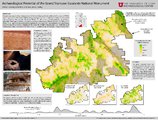 |
Yaworsky, Peter M. | Archaeological Potential of the Grand Staircase-Escalante National Monument | Executive proclamation 9682 reduces the size of the Grand Staircase-Escalante National Monument (GSENM), removing protections for at least 2,000 known archaeological sites and an unknown number of undiscovered cultural properties. Because only 10% of the GSENM's 1.9 million acres has been inventorie... | Grand Staircase-Escalante National Monument; Anthropology-Research | 2018 |
| 6 |
 |
McElreath, Richard | Are peasants risk-averse decision makers? | For decades, researchers studying small-scale, subsistence-oriented farmers have sought to explain why these "peasants" seem slow to acquire new technologies, novel agricultural practices, and new ideas from the larger societies that have engulfed them. The early work on this question suggested that... | Subsistance farmers; Risk-aversion; Risk-taking; Cultural conservatism; Cost-benefit analysis | 2002 |
| 7 |
 |
O'Rourke, Dennis H. | Ascertainment bias for non-twin relatives in twin proband studies | When families are ascertained through affected twins, as for example when twin probands are selected from a registry and their non-twin relatives studied, a correction for ascertainment bias is needed. It is shown that probandwise counting (where relatives of doubly ascertained twin pairs are counte... | Genetic; Transmission; Models | 1982 |
| 8 |
 |
Rogers, Alan R.; Jorde, Lynn B. | Ascertainment bias in estimates of average heterozygosity | Population geneticists work with a nonrandom sample of the human genome. Conventional practice ensures that unusually variable loci are most likely to be discovered and thus included in the sample of loci. Consequently, estimates of average heterozygosity are biased upward. In what follows we descri... | Bias (Epidemiology); Biometry; Heterozygote | 1996-05 |
| 9 |
 |
Hawkes, Kristen | Assignment of relationship terms in Binumarien | Kinship systems have a perennial fascination. From Morgan's day to the present, a long succession of authors have produced their diagrams and algebraic explanations . . . Kinship terminology and its diagramatic arrangements provide, ready made, a delightful series of mathematical abstractions and it... | Binumarien; Binumariens | 1977 |
| 10 |
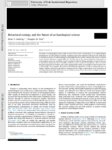 |
Codding, Brian | Behavioral ecology and the future of archaeological science | The future of archaeological science relies as much (if not more) on theoretical as on methodological developments. As with anything in biology, explaining past human behavior will require the application of evolutionary theory. As with anything in archaeology, theory is useless without clear ties t... | 2015-01-01 | |
| 11 |
 |
Hawkes, Kristen | Binumarien color categories | This paper has two aims. The first is to describe an ethnographically new system of color classification, Binumarien, a non-Austronesian or Papuan language of the Eastern Central Highlands of New Guinea2. In this connection we are particularly interested in relating our data to the Berlin and Kay (1... | Binumarien; Binumariens | 1975 |
| 12 |
 |
O'Rourke, Dennis H. | Biochemical heterozygosity and morphologic variation in a colony of papio hamadryas hamadryas baboons | This analysis examines the association between genetic heterozygosity and individual morphologic variation in a captive population of Papio hamadryas hamadryas consisting of 403 juveniles and adults. The population structure of the colony was artificially generated and maintained and is thus rigoro... | Population genetics; Polygenic; Inbreeding | 1994 |
| 13 |
 |
McElreath, Richard | Can females gain additional paternal investment by mating with multiple males? a game theoretic approach | Although females may require only one mating to become inseminated, many female animals engage in costly mating with multiple males. One potential benefit of polyandrous mating is gaining parental investment from multiple males. We developed two game theoretic models to explore this possibility. Our... | Female multiple mating; Polyandry; Nonprocreative mating; Paternal investment; Mating benefits; Mating strategy | 2001-11 |
| 14 |
 |
Broughton, John | Cathedral cave fishes | Table XLI provides the numbers of identified fish specimens by element from Stratum II at Cathedral Cave. The criteria used to arrive at those identifications are provided in chapter nine. A total of 547 identified fish specimens are represented in this deposit; all of those are sculpin. The mottled... | Homestead Cave; Ichthyofauna; Lake Bonneville | 2000 |
| 15 |
 |
Codding, Brian | Codding, Brian: Living outside the box: An updated perspective on diet breadth and sexual division of labor in the Prearchaic Great Basin [Author's Manuscript] | A tremendous amount has been learned about the Prearchaic (before 9000 BP) Great Basin since we advocated a perspective of sexual division of labor based on Human Behavioral Ecology a decade ago. Many investigators have taken our advice and a few have challenged our assumptions and inferences. One o... | 2014-01-01 | |
| 16 |
 |
Cashdan, Elizabeth A. | Competition between foragers and food producers on the Botletli River, Botswana | The immigration of food-producing groups into areas occupied by hunters and gatherers must have been a common occurrence in prehistory. How were the hunter-gatherers affected by this? I describe here two groups of Kalahari Basarwa ('Bushmen'), one living along the flood plain of the lower Botletli ... | Kalahari Basarwa; Bushmen; Foraging; Cattle | 1986 |
| 17 |
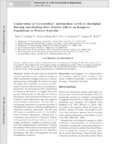 |
Codding, Brian | Conservation or co-evolution? Intermediate levels of aboriginal burning and hunting have positive effects on kangaroo populations in Western Australia | Studies of conservation in small scale societies typically portray indigenous peoples as either sustainably managing resources, or forsaking long-term sustainability for short-term gains. To explain this variability, we propose an alternative framework derived from a co-evolutionary perspective. In ... | 2014-01-01 | |
| 18 |
 |
Harpending, Henry C.; Jorde, Lynn B. | Culture creates genetic structure in the Caucasus: autosomal, mitochondrial, and Y-chromosomal variation in Daghestan | Near the junction of three major continents, the Caucasus region has been an important thoroughfare for human migration. While the Caucasus Mountains have diverted human traffic to the few lowland regions that provide a gateway from north to south between the Caspian and Black Seas, highland populat... | Caucasus; Haplogroups; Autosomal variation; Mitochondrial variation; Y-chromosomal variation; Endogamy; Avar; Dargin; Kubachi; Culture | 2008 |
| 19 |
 |
Hawkes, Kristen | The derived features of human life history | This chapter compares and contrasts the life histories of extant great apes in order to construct a hypothetical life history of the last common ancestor of all great apes and to identify features of human life history that have been derived during the evolution of our lineage. Data compiled from th... | 2006-01-01 | |
| 20 |
 |
Harpending, Henry C.; Rogers, Alan R. | Detecting positive selection from genome scans of linkage disequilibrium | Though a variety of linkage disequilibrium tests have recently been introduced to measure the signal of recent positive selection, the statistical properties of the various methods have not been directly compared. While most applications of these tests have suggested that positive selection has pl... | Genome scans; Linkage disequilibrium; Gene trees | 2010 |
| 21 |
 |
Rogers, Alan R. | Doubts about isonymy | The method of isonymy, developed by Crow and Mange for estimating inbreeding from surname frequencies, requires an assumption that has not been appreciated: It is necessary to assume that all males in some ancestral generation, the founding stock, had unique surnames. Because this assumption is sel... | 1991 | |
| 22 |
 |
Bell, Adrian | Driving factors in the colonization of Oceania: developing island-level statistical models to test competing hypotheses (Electronic Supporting Material) | To test the model specification and fitting algorithms, we simulated data using randomly generated parameters, settlement chronology, and accessibility matrix for N islands. Using the function optim in R, we found the maximum likelihood estimates and compared them with the "true" parameter values us... | Oceania; Archaeology; Settlement; Statistical models | 2015-01-23 |
| 23 |
 |
McElreath, Richard | Economic man in cross-cultural perspective: behavioral experiments in 15 small-scale societies | Since "Selfishness examined . . ." (Caporael et al. 1989) appeared in these pages, more than 15 years ago, many additional experiments have strongly confirmed the doubts expressed by Caporael and her collaborators concerning the adequacy of self-interest as a behavioral foundation for the social sci... | Economic outcomes; Selfishness; Fairness; Reciprocity | 2005 |
| 24 |
 |
Codding, Brian F. | Environmental productivity predicts migration, demographic, and linguistic patterns in prehistoric California | Global patterns of ethnolinguistic diversity vary tremendously. Some regions show very little variation even across vast expanses, whereas others exhibit dense mosaics of different languages spoken alongside one another. Compared with the rest of Native North America, prehistoric California exemplif... | Colonization of North America; Prehistoric migrations; Human behavioral ecology; Ideal free distribution; Ideal despotic distribution | 2013-09-03 |
| 25 |
 |
Cashdan, Elizabeth A. | Ethnocentrism and xenophobia: a cross-cultural study | Analyzes the factors influencing ethnic affiliation and interethnic hostility. Relationship between intraethnic loyalty and risk of famine; Continuity of violence at different levels of groupings; Analysis of local and intercommunity conflict. | Ethnic relations; Ethnology | 2006-06-06 |
| 26 |
 |
McCullough, John M. | Evidence for assortative mating and selection in surnames: a case from Yucatan, Mexico | Surnames are often used as metaphors for genetic material on the assumption of neutrality and general immunity from systematic pressures. The Yucatec Maya use surnames of both Maya and Spanish origin. We find evidence of positive assortative mating by ethnic origin of surname and a slight bias away ... | Surnames; Assortative mating; Maya | 1985 |
| 27 |
 |
Rogers, Alan R. | Evolution of time preference by natural selection | This paper entertains the hypothesis that human time preferences are in evolutionary equilibrium (i.e. that no mutation changing time preferences could be favored by natural selection). This hypothesis implies that the marginal rate of substitution (MRS) holding Darwinian fitness constant must equal... | Capitalism; Econometric models; Equilibrium | 1994-06 |
| 28 |
 |
Codding, Brian F. | Explaining prehistoric variation in the abundance of large prey: a zooarchaeological analysis of deer and rabbit hunting along the Pecho Coast of Central California | Three main hypotheses are commonly employed to explain diachronic variation in the relative abun dance of remains of large terrestrial herbivores: (1) large prey populations decline as a function of anthro pogenic overexploitation; (2 ) large prey tends to increase as a result of increasing social p... | Foraging; Resource depression; Prestige hunting; Paleoclimatic variability; Human behavioral ecology; Zooarchaeology; Central California | 2009-11-14 |
| 29 |
 |
Codding, Brian F. | External impacts on internal dynamics: Effects of paleoclimatic and demographic variability on acorn exploitation along the Central California coast | Research into human-environment interaction in California prehistory often focuses on either the internal dynamics of adaptive decisions or the external impacts of environmental change. While both processes were surely driving prehistoric variability, integrating these approaches is not altogether s... | Acorn exploitation; Prehistoric land use; Behavioral ecology | 2016 |
| 30 |
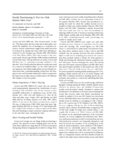 |
Hawkes, Kristen | Family provisioning is not the only reason men hunt | Gurven and Hill (2009) ask, "Why do mean hunt?" As they say, "The observation that mean hunt and women gather supported the simplistic view of marriage as a cooperative enterprise. Greater sophistication suggests that males may often be motivated by mating and status rather than offspring investment... | 2010-01-01 | |
| 31 |
 |
Broughton, John | Fish remains dominate Barn Owl pellets in northwestern Nevada | The foraging ecology of the Barn Owl (Tytoalba) has been studied extensively, both in the New World (Marti 1988, Castro and Jaksic 1995, Van Vuren and Moore 1998, and others) and the Old World (Glue 1967, Yom-Tov and Wool 1997, and others). Small rodents, insectivores, and small birds are generally ... | Barn Owl pellets; Northwestern Nevada; Fish; Fish remains | 2006 |
| 32 |
 |
Hawkes, Kristen | Food sharing among Ache hunter-gatherers of Eastern Paraguay | Empirical research on food sharing among hunter-gatherers should provide critical data for evaluating both the possible role of food sharing in hominid evolution and the question of how such behavior could be selected. | Hunter-gatherers; Ache; Paraguay; Anthropology | 1988-02 |
| 33 |
 |
Rogers, Alan R.; Jorde, Lynn B. | Founder effect: assessment of variation in genetic contributions among founders | We present a Monte Carlo method for determining the distribution of founders' genetic contributions to descendant cohorts. The simulation of genes through known pedigrees generates the probability distributions of contributed genes in recent cohorts of descendants, their means, and their variances. | 1994 | |
| 34 |
 |
Rogers, Alan R. | Genetic evidence for a Pleistocene population explosion | Expansions of population size leave characteristic signatures in mitochondrial "mismatch distributions." Consequently, these distributions can inform us about the history of changes in population size. Here, I study a simple model of population history that assumes that, t generations before the pr... | 1995 | |
| 35 |
 |
Rogers, Alan R.; Jorde, Lynn B. | Genetic evidence on modern human origins | A review of genetic evidence leads to the following conclusions concerning human population history: (1) Between 33,000 and 150,000 years ago the human population expanded from an initial size of perhaps 10,000 breeding individuals, reaching a size of at least 300,000. (2) Although the initial popu... | Population history; Mitochondrial DNA; Mismatch distribution; Intermatch distribution; Replacement hypothesis; Population bottlenecks | 1995 |
| 36 |
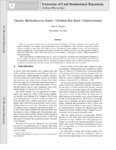 |
Rogers, Alan R. | Genetic relatedness to sisters children has been underestimated | Males of many species help in the care and provisioning of offspring, and these investments often correlate with genetic relatedness. For example, many human males invest in the children of sisters, and this is especially so where men are less likely to share genes with children of wives. Although t... | 2013-01-01 | |
| 37 |
 |
Rogers, Alan R.; Harpending, Henry C. | Genetic structure of ancient human populations | Discusses mitochondrial DNA (mtDNA) sequences as important source of data about the history of human species. | Tree of descent; Mismatch distributions; Simulations; Findings; Intermatch distributions; Younger and older populations | 2001-09-15 |
| 38 |
 |
Rogers, Alan R.; Jorde, Lynn B. | Genetic structure of the Utah Mormons: comparison of results based on RFLPs, blood groups, migration matrices, isonymy, and pedigrees | The genetic structure of the Utah Mormon population is examined using 25 blood group and 47 RFLP alleles obtained from 442 subjects living in 8 geographic subdivisions. Nei's Gst was 0.013 (p < 0.002) for the RFLP data and 0.012 (p > 0.4) for the blood group data, showing that only 1% of the geneti... | 1994 | |
| 39 |
 |
Rogers, Alan R. | Genetic variation at the MCIR Locus and the time since loss of human body hair | The melanocortin I receptor (MCIR) locus makes a protein that affects the color of skin and hair. At this locus, amino-acid differences are entirely absent among African humans, abundant among non-Africans (especially Europeans), and abundant in chimpanzee/human comparisons (Rana et al. 1999, Hardin... | Nonsynonymous; Chimpanzee; Constraint | 2004 |
| 40 |
 |
Hawkes, Kristen; O'Connell, James F. | Global process and local ecology: how should we explain differences between the Hadza and the !Kung? | In this chapter we discuss explanations for the diversity of behavior of contemporary forager populations. Other contributors document variation among southern African savanna Bushman groups, and central African forest Pygmies. We confine ourselves to trying to explain some differences between two ... | 1996 | |
| 41 |
 |
Hawkes, Kristen | Grandmothers and their consequences | Both what we share and don't share with our primate cousins make us human. Easy enough to start a list. At least since Darwin, most would rate moral sentiments as distinctively human. But our modern selves didn't emerge from ancestral apes in one step. When did populations along the way become human... | 2012-01-01 | |
| 42 |
 |
Rogers, Alan R. | Group selection by selective emigration: the effects of migration and kin structure | Group selection may operate through selective emigration, as Sewall Wright envisioned, as well as through selective extinction. The discrete-generation model of selective emigration developed here yields the following conclusions. 1. The fitness benefit of altruism, "depends on the frequency of altr... | Natural selection; Selective extinction; Evolution | 1990-03 |
| 43 |
 |
Hawkes, Kristen | Hadza children's foraging: juvenile dependency, social arrangement and mobility among hunter-gatherers | Presents a study on the foraging activities of Hadza children in Tanzania, Africa. Success of children's foraging; Determinants of children's foraging; Monitoring of the activities of children; Near-camp foraging return rates; Variables underlying the patterns of foraging. | Children; Foraging; Hazda; Hunter-gatherers | 1995 |
| 44 |
 |
Hawkes, Kristen | Hadza scavenging: implications for Plio/Pleistocene Hominid subsistence | The frequent association of stone tools and large animal bones in African Plio/Pleistocene archaeological sites has long been taken as evidence of the importance of hunting in early hominid diets. Many now argue that it reflects hominid scavenging, not hunting. | Hadza; Scavenging; Plio/Pleistocene; Hominid Diet | 1988-04 |
| 45 |
 |
Hawkes, Kristen | Hadza women's time allocation, offspring provisioning, and the evolution of long postmenopausal life spans | Extended provisioning of offspring and long postmenopausal life spans are characteristic of all modern humans but no other primates. These traits may have evolved in tandem. Analysis of relationships between women's time allocation and children's nutritional welfare among the Hadza of northern Tanza... | Child care; Children, nutrition; Life spans, Biology; Mother & child; Primates; Social structure; Women; Time Management; Hominids | 1997 |
| 46 |
 |
Broughton, John | Homestead cave Ichthyofauna | Biological evidence on the climatic and hydrographic history of the intermountain region would be much richer, if we had more than the present dribble of paleontological data on the fishes (Hubbs and Miller, 1948, p. 25). In this passage from their landmark synthesis of historical fish biogeograph... | Homestead Cave; Ichthyofauna; Lake Bonneville | 2000 |
| 47 |
 |
Rogers, Alan R. | How much can fossils tell us about regional continuity? | Presents a study on the genetic contribution of earlier populations to later populations within regions called regional continuity. Testing for regional continuity with multiple characters; Replacement of archaic population by a population of modern humans. | Human genetics; Fossils; Regional continuity | 2006-06-05 |
| 48 |
 |
Cashdan, Elizabeth A. | How women compete | Men are more physically aggressive and more risk-prone than women, but are not necessarily more competitive. New data show the gender difference in competitiveness to be one of kind rather than degree, with women and men competing in different ways and, to some extent, over different objectives, but... | Gender differences, behavior; Competition; Aggression | 1999-06 |
| 49 |
 |
O'Rourke, Dennis H. | Hrdlič̌ka's Aleutian population-replacement hypothesis: a radiometric evaluation | In a 1945 monograph, Hrdlička argued that, at 1,000 BP, Paleo-Aleut people on Umnak Island were replaced by Neo-Aleut groups moving west along the island chain. His argument was based on cranial measurements of skeletal remains from Chaluka Midden and mummified remains from Kagamil and Ship Rock b... | Population replacement; Paleo-Aleuts; Neo-Aleuts | 2006 |
| 50 |
 |
Hawkes, Kristen | Human life histories: primate trade-offs, grandmothering socioecology, and the fossil record | Human life histories differ from those of other animals in several striking ways. Recently Smith and Tompkins (1995, p. 258) highlighted the combination of "slow" and "fast" features of human lives. Our period of juvenile dependency is unusually long, our age at first reproduction is late, and we h... | Meat; Maturity; Life Span | 2003 |
| 51 |
 |
Hawkes, Kristen | Hunting and nuclear families: some lessons from the Hadza about men's work | Hadza hunter-gatherers display economic and social features usually assumed to indicate the dependence of wives and children on provisioning husbands and fathers. The wives and children of better Hadza hunters have been found to be better-nourished, consistent with the assumption that men hunt to pr... | Subsistence economy; Tindiga, African people; Subsistence hunting | 2001-10-24 |
| 52 |
 |
Hawkes, Kristen | Hunting and the evolution of egalitarian societies: lessons from the Hadza | Political hierarchies are common in human societies but absent among many mobile hunter-gatherers. So egalitarian social organizations have been attributed to limits that foraging imposes on wealth accumulation. But male-dominance hierarchies characterize all the great apes, our nearest relatives. ... | 2000 | |
| 53 |
 |
McElreath, Richard | In search of homo economicus: behavioral experiments in 15 small scale societies | Recent investigations have uncovered large, consistent deviations from the predictions of the textbook representation of Homo economicus One problem appears to lie in economists' canonical assumption that individuals are entirely self-interested: in addition to their own material payoffs, many exper... | Economic behavior; Self-interest; Fairness; Reciprocity | 2001 |
| 54 |
 |
Codding, Brian F. | Interpreting abundance indices: some zooarchaeological implications of Martu foraging | Indices of taxonomic abundance are commonly used by zooarchaeologists to examine resource inten sification, overexploitation and gender divisions in foraging labor. The original formulation of abundance indices developed a clear interpretive framework by linking the measure with foraging models from... | Human behavioral ecology; Zooarchaeology; Ethnoarchaeology; Resource intensification; Gender division of labor; Western Australia | 2010-07-20 |
| 55 |
 |
O'Rourke, Dennis H. | Introduction: origins and settlement of the indigenous populations of the Aleutian Archipelago | The series of papers in this special issue of Human Biology use an interdisciplinary approach to address regional questions and to integrate disparate Aleutian data into a broad, synthetic effort. The contributors leverage decades of data on Aleut origins, biogeography, and behavior through integrat... | 2010 | |
| 56 |
 |
Rogers, Alan R. | Is migration kin structured? | We estimate the strength of kin-structured migration in six human populations (five from New Guinea and one from Finland) and in one population of nonhuman primates. We also test the hypothesis that migration is not kin structured by generating a sampling distribution of the estimator under the null... | 1994 | |
| 57 |
 |
Harpending, Henry C. | J. P. Rushtons theory of ethnic nepotism | Unreciprocated aid among co-ethnics and the emotional intensity of ethnic conflict have long been explanatory challenges to evolutionary science. J. P. Rushton's theory of assortative ethnic affiliation-altruism, mating and friendship directed towards fellow ethnics-derives from his more general the... | 2012-01-01 | |
| 58 |
 |
Loeb, Laurence D. | Laurence Loeb slides | |||
| 59 |
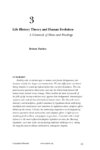 |
Hawkes, Kristen | Life history theory and human evolution : a chronicle of ideas and findings | Fertility ends at similar ages in women and female chimpanzees, but humans usually live longer and mature later. We also differ from our closest living relatives in weaning infants before they can feed themselves. The comparisons pose questions about when and why the distinctively human life history... | 2006-01-01 | |
| 60 |
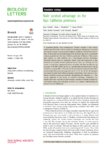 |
Macfarlan, Shane | Male Survival Advantage on the Baja California Peninsula | A consistent finding from contemporary Western societies is that women outlive men. However, what is unclear is whether sex differences in survival are constant across varying socio-ecological conditions. We test the universality of the female survival advantage with mortality data from a nineteenth... | ecology; health and disease and epidemiology; behaviour | 2020 |
| 61 |
 |
Rogers, Alan R. | Migration and genetic drift in human populations | In humans and many other species, mortality is concentrated early in the life cycle, and is low during the ages of dispersal and reproduction. Yet precisely the opposite is assumed by classical population-genetics models of migration and genetic drift. We introduce a model in which population regul... | Frequencies; Variance; Dynamics | 1986 |
| 62 |
 |
Rogers, Alan R.; Harpending, Henry C. | Mismatch distributions of mtDNA reveal recent human population expansions | Although many genetic studies of human evolution have tried to make distinctions between the replacement and the multiregional evolution hypotheses, current methods and data have not resolved the issue. However, new advances in nucleotide divergence theory can complement these investigations with a ... | 1994 | |
| 63 |
 |
Rogers, Alan R. | Model of kin-structured migration | When individuals disperse from one local group to another, they often do so in the company of relatives. This is known as "kin-structured migration," and its effect on genetic population structure is investigated here. It is shown that when migration is kin-structured, the ratio of between- to with... | Fission; Mobility; Population | 1987 |
| 64 |
 |
Rogers, Alan R.; Jorde, Lynn B. | Modeling the amplification dynamics of human Alu retrotransposons | Retrotransposons have had a considerable impact on the overall architecture of the human genome. Currently, there are three lineages of retrotransposons (Alu, L1, and SVA) that are believed to be actively replicating in humans. While estimates of their copy number, sequence diversity, and levels of ... | Retrotransposons; Amplification dynamics; Mutation; Human-chimpanzee divergence | 2005 |
| 65 |
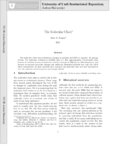 |
Rogers, Alan R. | The molecular clock | The molecular clock uses evolutionary changes in proteins and DNA to measure the passage of time. Yet molecular evolution is clocklike only to a first approximation. Uncertainties arise because of variation in rates of molecular evolution, because of difficulty in calibrating clocks, and because we ... | 2013-01-01 | |
| 66 |
 |
McElreath, Richard | New methods in quantitative ethnography: economic experiments and variation in the price of equality | A new method for quantitatively documenting concerns for economic fairness has the potential for identifying variation in prosociality within and across societies. Multiple dictator games conducted in two small-scale societies presented decision makers with a choice between an equitable and an ine... | Inequality; Payoffs; Prosociality | 2007-12 |
| 67 |
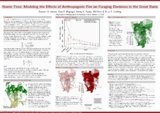 |
Vernon, Kenneth B. | Numic fires: modeling the effects of anthropogenic fire on foraging decisions in the Great Basin | Across Western North America, hunter-gatherers modified their surrounding environment with the application of fire (1; 11; 15). However, to date we lack a general theoretical framework to investigate the reasons why people would burn or its effects on traditional foraging economies. To begin to fill... | Behavioral ecology; Diet; Fire | 2015 |
| 68 |
 |
Wiessner, Pauline W. | On emergency decisions, egalitarianism, and group selection | Boehm (CA 37:763-93) puts forward an important thesis-that with the evolution of egalitarian societies, privileged routes to reproductive advantage are blocked and the power of individua selection severely compromised. With competition so constrained, altruistic behavior can more readily spread i... | Boehm's mode; Evolution of altruistic behavior | 1998-06 |
| 69 |
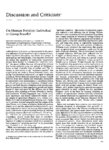 |
Hawkes, Kristen | On Human fertility: Individual or group benefit? | Caldwell et al. (CA 28:25-43) have pointed to the pervasive influence of Carr-Saunders's (1922) concept of population regulation throughout two-thirds of a century of anthropology and demography. | 1988-01-01 | |
| 70 |
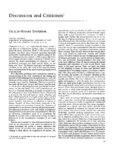 |
Hawkes, Kristen | On life history evolution (a comment on Chisholm) | Chisholm (CA 34:I-24) is right that the theory, models, and data of evolutionary biology apply to questions asked by social scientists. Work in life-history theory (Stearns 1992, Roff 1992, Charnov 1993) has especially provocative implications for the understanding of human development (see review i... | 1994-01-01 | |
| 71 |
 |
Wiessner, Pauline W. | On network analysis: the potential for understanding (and misunderstanding) !Kung Hxaro | Schweizer's social network analysis (CA 38: 739-52) of gift giving among the !Kung San (Ju/'hoansi) demonstrates most elegantly how individual strategies, guided by basic cultural rules, coalesce to form a regional system. Complex connections in the network that defied description with simpler anayt... | Density of kinship; Nonsymmetry; Ethnohistorica | 1998-08 |
| 72 |
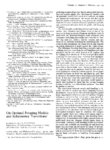 |
Hawkes, Kristen | On optimal foraging models and subsistence transitions | Layton, Foley, and Williams are right: "progress" doesn't explain transitions from hunting and gathering to agriculture, by theory and models from behavioral ecology might. | 1992-01-01 | |
| 73 |
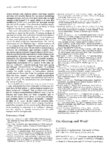 |
Hawkes, Kristen | On sharing and work (a comment on Bird-David) | Bird-David (CA 33:25-47) discusses reasons for the persistent vitality and wide appeal of Sahlins's influential characterization of hunter-gatherers as representatives of 'original affluence." | 1992-01-01 | |
| 74 |
 |
Cashdan, Elizabeth A. | On territoriality in hunter-gatherers | Cashdan's intention of using an evolutionary framework to examine cross-cultural variations in territorial defense is admirable, but her argument about the applicability of available models, her own model, and the data used to support it (CA 24:47-66) are all severely flawed. Specifically, Cashdan ... | Defense; Organisms; Behavior | 1983 |
| 75 |
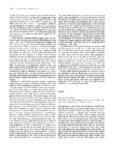 |
Hawkes, Kristen | On why male foragers hunt and share food: Reply to Hill and Kaplan | My argument is this: Some food resources, notably large animals when they are unpredictably acquired, are too expensive to defend. Other can claim shares of them without repaying shares of the same foods later. | 1993-01-01 | |
| 76 |
 |
Rogers, Alan R.; Jorde, Lynn B. | Origins and affinities of modern humans: a comparison of mitochondrial and nuclear genetic data | To test hypotheses about the origin of modern humans, we analyzed mtDNA sequences, 30 nuclear restriction-site polymorphisms (RSPs), and 30 tetranucleotide short tandem repeat (STR) polymorphisms in 243 Africans, Asians, and Europeans. An evolutionary tree based on mtDNA displays deep African branch... | Base Sequence; Variation (Genetics); Base Sequence | 1995 |
| 77 |
 |
Harpending, Henry C. | Paternal age and genetic load | The incidence of base substitutions in humans increases with the age of the father, which shows up as an increased incidence of mutational disorders in the children of older fathers. There is a less obvious implication: an extended period of high average paternal age in a population will lead to inc... | 2013-01-01 | |
| 78 |
 |
O'Rourke, Dennis H. | Patterns of genetic variation in native America | Allele frequencies from seven polymorphic red cell antigen loci (ABO, Rh, MN, S, P, Duffy, and Diego) were examined in 144 Native American populations. Mean genetic distances (Nei's D) and the fixation index FST are approximately equal for the North and South American samples but are reduced in the... | Gene frequencies; Amerinds; Genetic Distance | 1992 |
| 79 |
 |
Rogers, Alan R. | Pleistocene population X-plosion? | In two recent papers, Kaessmann et al. presented DNA sequence data from the X chromosome (Xq13.3) of 30 chimpanzees and 69 humans (Kaessmann et al. 1999a; Kaessmann et al. 1999b). These data bear on two longstanding questions involving late Pleistocene demographic history: (1) whether the long-term... | 2000 | |
| 80 |
 |
Rogers, Alan R. | Population differences in quantitative characters as opposed to gene frequencies | Hypotheses about evolution can be tested by comparing genetics differences with those of quantitative characters. Such comparisons are one source of information concerning the forces that maintain variation among natural populations. | Genes; Evolution; Anthropology | 1986-05 |
| 81 |
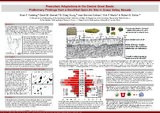 |
Codding, Brian F. | Prearchaic Adaptations in the Central Great Basin: Preliminary findings from a stratified open-air site in Grass Valley, Nevada | Early Holocene occupants of the Great Basin preferentially occupied highly productive habitats surrounding pluvial lakes. While growing evidence details in the adaptations of these Prearchaic foragers in the Eastern (e.g., Madsen et al. 2015) and Western Great Basin (e.g., Jenkins et al. 2012), our... | Anthropology, Cultural - methods - United States; Anthropology, Cultural - methods - Great Basin; Anthropology - Grass Valley, Nevada | 2016 |
| 82 |
 |
Vernon, Kenneth B. | Prearchaic land use in Grass Valley, Nevada: A novel statistical implementation of optimal distribution modeling | Using Prearchaic (PA) sites in Grass Valley, NV (Fig. 1), this project investigates (i) environmental factors driving variation in PA settlement and (ii) geomorphological factors driving variation in PA surface visibility. Building on previous research [1,2], we evaluate variables using Ideal Free D... | Prearchaic - Great Basin; Ideal Free Distribution; Maximum Entropy | 2018 |
| 83 |
 |
Broughton, John | Prehistoric human impacts on California birds: evidence from the Emeryville Shellmound Avifauna | The abundance of artiodactyls, marine mammals, waterfowl, seabirds, and other animals in 18th- and 19th-century California astonished early explorers, and the incredible wildlife densities reported in their accounts are routinely taken as analogues for the original or pristine zoological condition. ... | Avifauna; Prehistoric hunting; Biological evaluation of environmental impacts | 2004 |
| 84 |
 |
Loeb, Laurence D. | Prestige and piety in the Iranian synagogue | Among Iranian Jews, long deprived of meaningful political power and afraid to conspicuously display material wealth, relative prestige became more valued that authority of opulence. The synagogue provides the traditional public forum where meaningful interaction among its members reinforces rand dif... | Shirazi Jewish Socieity | 1978 |
| 85 |
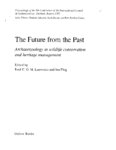 |
Broughton, John | Pristine benchmarks and indigenous conservation? Implications from California zooarchaeology | The superabundance of tame wildlife during the early historic period in California astonished European explorers. And the historic accounts of incredible animal densities, most notably artiodactyls, have influenced a long-held perception that California Indians lived in harmony with nature. However,... | 2004-01-01 | |
| 86 |
 |
Rogers, Alan R. | Quantitative genetics of sexual dimorphism in human body size | A classical data set is used to predict the effect of selection on sexual dimorphism and on the population means of three characters--stature, span, and cubit--in humans. Given selection of equal intensity, the population means of stature and of cubit should respond more than 60 times as fast as d... | Societies; Selection; Species | 1992 |
| 87 |
 |
O'Rourke, Dennis H. | Refutation of the general single locus model for the etiology of schizophrenia | All published studies on the familial incidence of schizophrenia appropriate for testing the applicability of the general single-locus two-allele model are examined under the assumption of a unitary etiology for all schizophrenia. We show that the single major locus model is inadequate to predict th... | Genetics; Diseases in Twins; Chromosome Mapping | 1982 |
| 88 |
 |
McCullough, John M. | Relatedness and kin-structured migration in a founding population: Plymouth colony, 1620-1633 | To test the common assumption of no genetic relationship in a founding population, we calculated average relatedness (r) for the emigrants to Plymouth Colony from Europe on seven voyages from 1620 to 1633. Of 355 individuals, 255 could be individually identified and 4 generations of genealogic depth... | 1991 | |
| 89 |
 |
Broughton, John | Resource intensification and late Holocene human impacts on Pacific coast bird populations: evidence from the Emeryville shellmound avifauna | Anthropologists and conservation biologists have commonly assumed that the distributions and abundances of vertebrate resources recorded during the early historic period in North America reflected a "pristine" condition. This view follows from the perception that Native American population densities... | Resource intensification; Holocene human impacts; Foraging efficiency; Harvest pressure; Bird populations; Emeryville shellmound | 2001 |
| 90 |
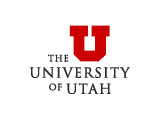 |
Loeb, Laurence D. | Sanandaj (reel five, side one) | This is an audio recording made by the author. We are in the process of gathering complete metadata from the author. | ||
| 91 |
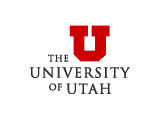 |
Loeb, Laurence D. | Sanandaj (reel five, side two) | This is an audio recording made by the author. We are in the process of gathering complete metadata from the author. | ||
| 92 |
 |
Loeb, Laurence D. | Sanandaj Rezaiyeh (reel six, side one) | This is an audio recording made by the author. We are in the process of gathering complete metadata from the author. | ||
| 93 |
 |
Loeb, Laurence D. | Sanandaj Rezaiyeh (reel six, side two) | This is an audio recording made by the author. We are in the process of gathering complete metadata from the author. | ||
| 94 |
 |
Cashdan, Elizabeth A. | Sex differences in aggression: what does evolutionary theory predict? | The target article claims that evolutionary theory predicts the emergence of sex differences in aggression in early childhood, and that there will be no sex difference in anger. It also finds an absence of sex differences in spousal abuse in Western societies. All three are puzzling from an evolutio... | 2009-08 | |
| 95 |
 |
McElreath, Richard | Shared norms and the evolution of ethnic markers | Unlike other primates, human populations are often divided into ethnic groups that have self-ascribed membership and are marked by seemingly arbitrary traits such as distinctive styles of dress or speech (Barth 1969, 1981). The modern understanding that ethnic identities are flexible and ethnic bou... | Ethnic groups; Ethnic identity; Migration; Markers | 2003-02 |
| 96 |
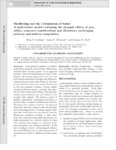 |
Codding, Brian | Shellfishing and the colonization of sahul: a multivariate model evaluating the dynamic effects of prey utility, transport considerations and life-history on foraging patterns and midden composition | Archaeological evidence of shellfish exploitation along the coast of Sahul (Pleistocene Australia-New Guinea) points to an apparent paradox. While the continental record as a whole suggests that human populations were very low from initial colonization through early Holocene, coastal and peri-c... | 2014-01-01 | |
| 97 |
 |
Broughton, John | Size of the bursa of fabricius in relation to gonad size and age in laysan and black-footed albatrosses | Age determination can be difficult for birds that undergo little or no plumage change during life. This is the case for Laysan and Black-footed Albatrosses (Diomedea immutabilis and D. nigripes). The juvenile plumage for both these North Pacific albatrosses is completely grown by about five to six m... | Birds; Species; Development | 1994 |
| 98 |
 |
McElreath, Richard | Social learning and the maintenance of cultural variation: an evolutionary model and data from East Africa | Human societies maintain between-group variation despite mixing of people and ideas. In order for variation to remain, migrants or their children must preferentially adopt local norms, customs, and beliefs. Yet the details of how cultural variation is maintained, despite mixing, remain unknown. This... | Cultural variation; cultural identity; East Africa | 2004 |
| 99 |
 |
Rogers, Alan R. | Sociobiology of sex and sexes (comment) | A comment on "Sociobiology of sex and sexes" by Marion Blute. | Sociobiology; Sex and sexes | 1984-04 |
| 100 |
 |
Codding, Brian F. | Socioecological dynamics structuring the spread of farming in the North American Basin-Plateau Region | The spread of agriculture is a major driver of social and environmental change throughout 25 the Holocene, yet experimental and ethnographic data indicate that farming is less profitable than foraging, so why would individuals choose to adopt agriculture leading to its expansion? Ideal distribution ... | Ideal free distribution model; population ecology; behavioral ecology; maize agriculture; Ancestral Puebloan; Fremont Complex | 2021 |
| 101 |
 |
Hawkes, Kristen | Some current ideas about the evolution of the human life history | Human life history is characterised by a long juvenile period (weaning to reproductive maturity), and a long post-reproductive lifespan in females. How do we explain the differences between our nearest relatives, the great apes, and ourselves? This chapter summarises some recent attempts to use l... | Human life history; Fertility; Apes; Juvenile period | 1999 |
| 102 |
 |
O'Rourke, Dennis H. | South from Alaska: a pilot aDNA study of genetic history on the Alaska Peninsula and the Eastern Aleutians | Abstract The Aleutian Islands were colonized, perhaps several times, from the Alaskan mainland. Earlier work documented transitions in the relative frequencies of mtDNA haplogroups over time, but little is known about potential source populations for prehistoric Aleut migrants. As part of a pilot i... | 2010 | |
| 103 |
 |
O'Rourke, Dennis H. | Spatial and temporal stability of mtDNA haplogroup frequencies in native North America | Mitochondrial DNA lineage frequencies in prehistoric Aleut, eastern Utah Fremont, Southwestern Anasazi, Pyramid Lake, and Stillwater Marsh skeletal samples from northwest Nevada and the Oneota of western Illinois are compared with those in 41 contemporary aboriginal populations of North America. T... | Mitochondrial DNA; Lineage variation; Haplogroup assignment | 2000 |
| 104 |
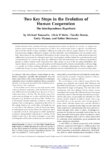 |
Hawkes, Kristen | Stag hunts or rearing environments? | Tomasello et al. have made the case that shared intentionality distinguishes humans from our nearest living relatives. What accounts for the difference? The answer they offer is Stag Hunt choices faced by ancestral foragers. Noting problems with that answer, I urge attention to a promising alternati... | 2012-01-01 | |
| 105 |
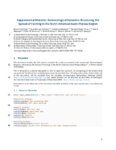 |
Codding, Brian F. | Supplementary Materials: Socioecological dynamics structuring the spread of farming in the North American Basin-Plateau Region | This document includes the code used to complete the analysis presented in the manuscript "Socioecological Dynamics Structuring the Spread of Farming in the North American Basin-Plateau Region" in Environmental 15 Archaeology. | environmental archaeology | |
| 106 |
 |
Cashdan, Elizabeth A. | Technological change and child behavior among the !Kung | How does change in one part of a social system affect other parts? This is the central question that must be answered in order to understand the process through which culture changes. This paper is about a small piece of the problem. It investigates how changes in subsistence economy affect child be... | Child behavior; Technological change; Foraging groups; Settled groups | 1988 |
| 107 |
 |
Broughton, John | Terminal Pleistocene fish remains from Homestead Cave, Utah, and implications for fish biogeography in the Bonneville Basin | Eleven fish species were identified from Homestead Cave, Utah. The remains, concentrated in the lowest stratum of the deposit, were accumulated by owls between approximately 11,200 and 10,100 14C yr B.P. and likely represent fish associated with the final die-off of the Lake Bonneville fauna. Fou... | Fish assemblage; Quaternary; Lake Bonneville | 2000 |
| 108 |
 |
Cashdan, Elizabeth A. | Territoriality among human foragers: ecological models and an application to four Bushman Groups | Discussions of human territoriality have become more sophisticated in recent years; we see fewer arguments for or against the adaptiveness of territoriality for mankind in general and more attempts to probe the ecological factors that make territoriality adaptive in particular circumstances. | Foraging; Ecological Models; Bushman | 1983-02 |
| 109 |
 |
O'Rourke, Dennis H. | Unangan past and present: the contrasts between observed and inferred histories | Abstract Academic research focusing on the population and culture history of the Aleut (Unangan) people began in the late 19th century and continues to the present. The papers in this special issue of Human Biology summarize the latest results from archaeological, linguistic, genetic, and morphometr... | 2010 | |
| 110 |
 |
Wiessner, Pauline W. | Vines of complexity - egalitarian structures and the institutionalization of inequality among the Enga | The initial stages of the institutionalization of hierarchical social inequalities remain poorly understood. Recent models have added important perspectives to "adaptationist" approaches by centering on the agency of "aggrandizers" who alter egalitarian institutions to suit their own ends through de... | Egalitarian structures; Political evolution; Social d | 2002-04 |
| 111 |
 |
Cashdan, Elizabeth A. | Waist-to hip ratio across cultures: trade-offs between androgen-and estrogen-dependent traits | A gynoid pattern of fat distribution, with small waist and large hips (low waist-to-hip ratio, or WHR) holds significant fitness benefits for women: women with a low WHR of about 0.7 are more fecund, are less prone to chronic disease, and (in most cultures) are considered more attractive. Why, then... | Fertility; Optimum; Fecundity | 2008 |
| 112 |
 |
Cashdan, Elizabeth A. | Waist-to-hip ratio across cultures: trade-offs between androgen- and estrogen-dependent traits | A gynoid pattern of fat distribution, with small waist and large hips (low waist-to-hip ratio, or WHR) holds significant fitness benefits for women: women with a low WHR of about 0.7 are more fecund, are less prone to chronic disease, and (in most cultures) are considered more attractive. Why, then... | Fat distribution; Gynoid pattern; Body types; Waist-to-hip ratio; WHR | 2008 |
| 113 |
 |
Wiessner, Pauline W. | Wealth transmission and inequality among hunter-gatherers | We report quantitative estimates of intergenerational transmission and population-wide inequality for wealth measures in a set of hunter-gatherer populations. Wealth is defined broadly as factors that contribute to individual or household well-being, ranging from embodied forms, such as weight and h... | 2010-02 | |
| 114 |
 |
McElreath, Richard | When natural selection favors imitation of parents | It is commonly assumed that parents are important sources of socially learned behavior and beliefs. However, the empirical evidence that parents are cultural models is ambiguous, and debates continue over their importance. A formal theory that examines the evolution of psychological tendencies to i... | Transmission; Evolution; Culture | 2008 |
| 115 |
 |
Hawkes, Kristen | Why hunter-gatherers work: An ancient version of the problem of public goods | From the abstract: People who hunt and gather for a living share some resources more widely than others. A favored hypothesis to explain the differential sharing is that giving up portions of large, unpredictable resources obligates others to return shares of them later, reducing everyone's variance... | Hunter-gatherer societies; Public goods | 2001-08 |
| 116 |
 |
Cashdan, Elizabeth A. | Why is testosterone associated with divorce in men? | There is evidence that in women high levels of testosterone are associated with more sexual partners and more permissive sexual attitudes. If a similar relationship holds true for men, the higher basal testosterone levels of divorced and unmarried men may be caused by this relationship rather than b... | Marriage; Separation; Hormones; Sexuality | 1998-06 |
1 - 200 of 116
